Paris 1944: True stories behind liberation from Nazis
- Published
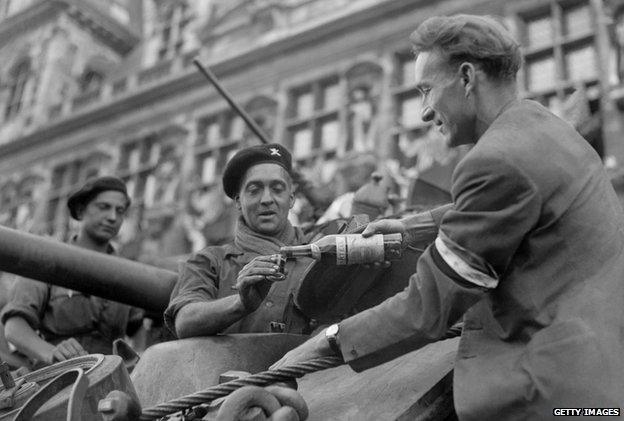
Paris was liberated by the French 2nd Armoured Division on 25 August 1944
On the morning of 19 August 1944, a 28-year-old Frenchman called Georges Loiseleur hurried down to the street from his flat on the Quai des Grands-Augustins.
Paris was abuzz. A short distance away, he could hear chaotic sounds from the Ile de la Cite, where police had come out for the Resistance and taken control of their HQ. The longed-for insurrection was under way.
Loiseleur was a former soldier who had escaped from prison camp in Germany. For the past two years he had been living and working in Paris in semi-clandestinity.
He was attached to a Resistance group, but like many other young men his instructions had been to wait. Now finally here was the chance to act.
The FFI (French Forces of the Interior - the main Resistance coalition) had warned there were not enough arms to go round. The first task of any would-be partisan was to get hold of a gun.
On the Quai des Grands-Augustins, which runs along the left bank of the Seine, a German lorry ran into an ambush. Someone threw a grenade and the vehicle careered onto its side.
Loiseleur was at the scene. He scrambled through the wreckage, looking for a weapon to take. But a German soldier had survived the attack. He drew his pistol, shot Loiseleur and killed him.
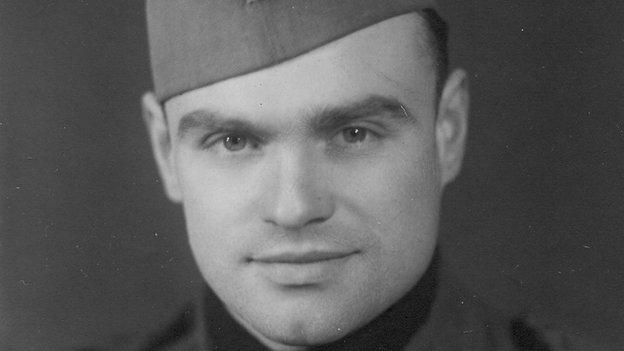
Georges Loiseleur was shot dead less than a week before Paris was liberated
Today, the spot where this happened is marked with a small plaque bearing the name of Georges Loiseleur, who "died for France". A 19 year old, Rene Dova, who was killed in the same incident is also remembered.
Across the city there are about 500 of these memorials dating from the week of fighting exactly 70 years ago, when Parisians won back their lost honour and threw off the Nazi yoke.
The earliest ones were put up spontaneously by families or comrades. Later, a law of 1946 set out strict rules about proof of merit, and about appropriate language.
Thus, while the first plaques use emotional phrases like "lachement assassine par les Boches" (victim of a cowardly murder by the Hun), the later formula "Mort pour la France" reflects an official appropriation of the act of memory.
Each memorial evokes a personal story from the liberation of Paris. But time is passing, and the memory of what actually happened at each of these 500 spots is fading.
An enthusiast called Gilles Primout has established a remarkable website, external in which relatives of victims of August 1944 can publish their family stories.
"My interest is in the detail of history," says Primout. "The battle for Paris was not really a battle at all. It was a series of street-level skirmishes.
"No-one knew much more than what they could see from their window. But what they saw was all part of the events."
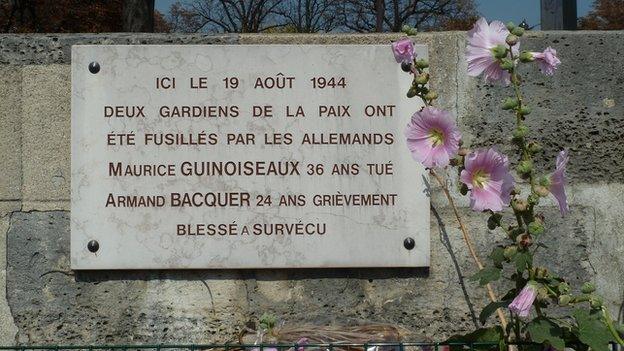
Armand Bacquer survived despite being shot 14 times by the Germans six days before liberation
Scores of people have sent in their memories. Mostly they are children and grandchildren of participants, retelling tales that have been told over the years around the kitchen table.
Georges Loiseleur's nephew Jean-Charles Ciza is one. He was a baby at the end of the war, but his elder sister remembered their uncle well.
"In our family we spoke a lot about Uncle Georges. My mother and my sister loved him. He was intelligent, cultured, athletic. He was someone I came to wish I had known," he says.
"That is why I wanted to tell his story on the website. Soon all direct memory of how he died will have disappeared. It is important to set it all out."
Among the many tales, there is that of Armand Bacquer, told by his son Joel.
Armand Bacquer was a 24-year-old policeman who was taken to be executed by the Germans on 19 August near the Place de la Concorde. Miraculously he survived 14 bullet wounds, and was granted the Legion of Honour 50 years later.
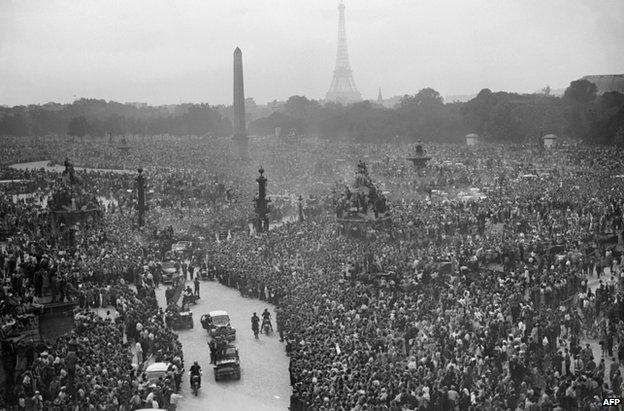
Crowds thronged the liberated Place de la Concorde in central Paris on 26 August
There is Yvonne, who as a girl of 16 saw her father being shot dead on the street outside her home on the Rue de Bourgogne by two members of a French pro-German militia.
And there is Nicole, who more than 60 years after the Liberation finally succeeded in getting a plaque in memory of her dead father, Etienne Lalis.
Curiously, the plaque bears the date 21 September 1944 - nearly a month after the fighting was over. But the story sheds light on how this was not just an anti-German struggle, but a bitter inter-French one too.
Etienne Lalis was a typesetter who provided forged documents to the Resistance and then fought honourably in the events of August. But he was gunned down with two others at 41 Rue des Vinaigriers in the 10th arrondissement (district) by a gang of unidentified men.
The crime was never solved. Some thought it was former members of a pro-Nazi militia who killed him. Others said he and the other officer killed (the third victim was the second man's wife) were looking too closely into the affairs of a notorious wartime profiteer.
In February 2006, Nicole was finally able to see her father's name commemorated.
"After the war my mother came to the scene, and there was a plaque remembering the two other murdered people but not my father. She could never understand why," she said.
For Gilles Primout one of the most touching stories is of a 13-year-old girl who was the sole survivor of a family killed in a German bombardment on 26 August.
"After Paris fell to the Allies, for a reason no-one has ever explained, the German air force carried out a series of bombing raids. Many people were killed.
"This girl had been sent for safety in Normandy. But her parents and her 15-year-old brother all died. While everyone else was celebrating, she had to cope with that.
"It is the kind of personal story that the history books never tell."
One group of people who have not been in touch with Gilles Primout are the famous "tondues" - the women whose heads were publicly shaved because of their alleged collaboration.
"Of course head-shaving happened in Paris as well as everywhere else, and there will certainly be some women still alive today who suffered it. But it was such a mark of shame. No-one will ever come forward."
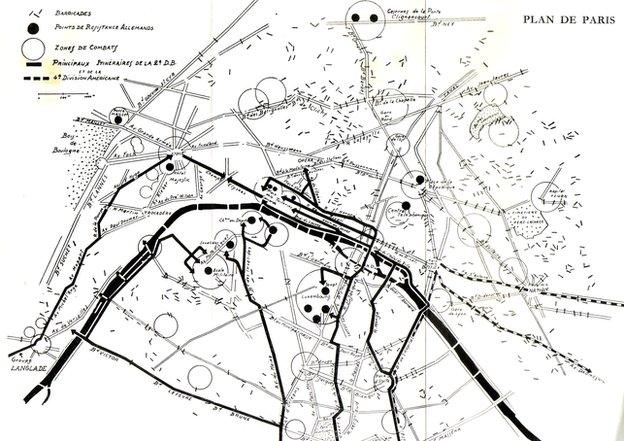
Black dots show the points of German resistance while the lines show the French and American routes
For Primout, the Paris uprising of August 1944 was important for the Allied effort - even if its symbolic value was perhaps even greater.
"The insurrection forced the Germans to bunker down in a small number of strong-points, and that made it a lot easier for the French army when it eventually arrived," he says.
"Of course, afterwards it was heavily mythologised. But it was necessary myth-making. De Gaulle needed to give the French that they had all played a role in liberating themselves - even if that was not true."
Today the Liberation plaques are decorated with flowers every August. But only a few family members still make the annual pilgrimage.
This year Sylviane Pommier once again laid a bouquet at the place where her uncle was shot dead on the Rue du Pere-Corentin in the 14th arrondissement.
"Gustave Pommier was my father's elder brother. He was in the Resistance, and on 21 August he was stopped by some German soldiers.
"We don't know what they found on him, but they beat him up and then they shot him dead. His body was found after the Liberation under a pile of sand," she says.
"Of course I never knew him. But my father loved him. And in our family we were always so proud."
- Published10 June 2014
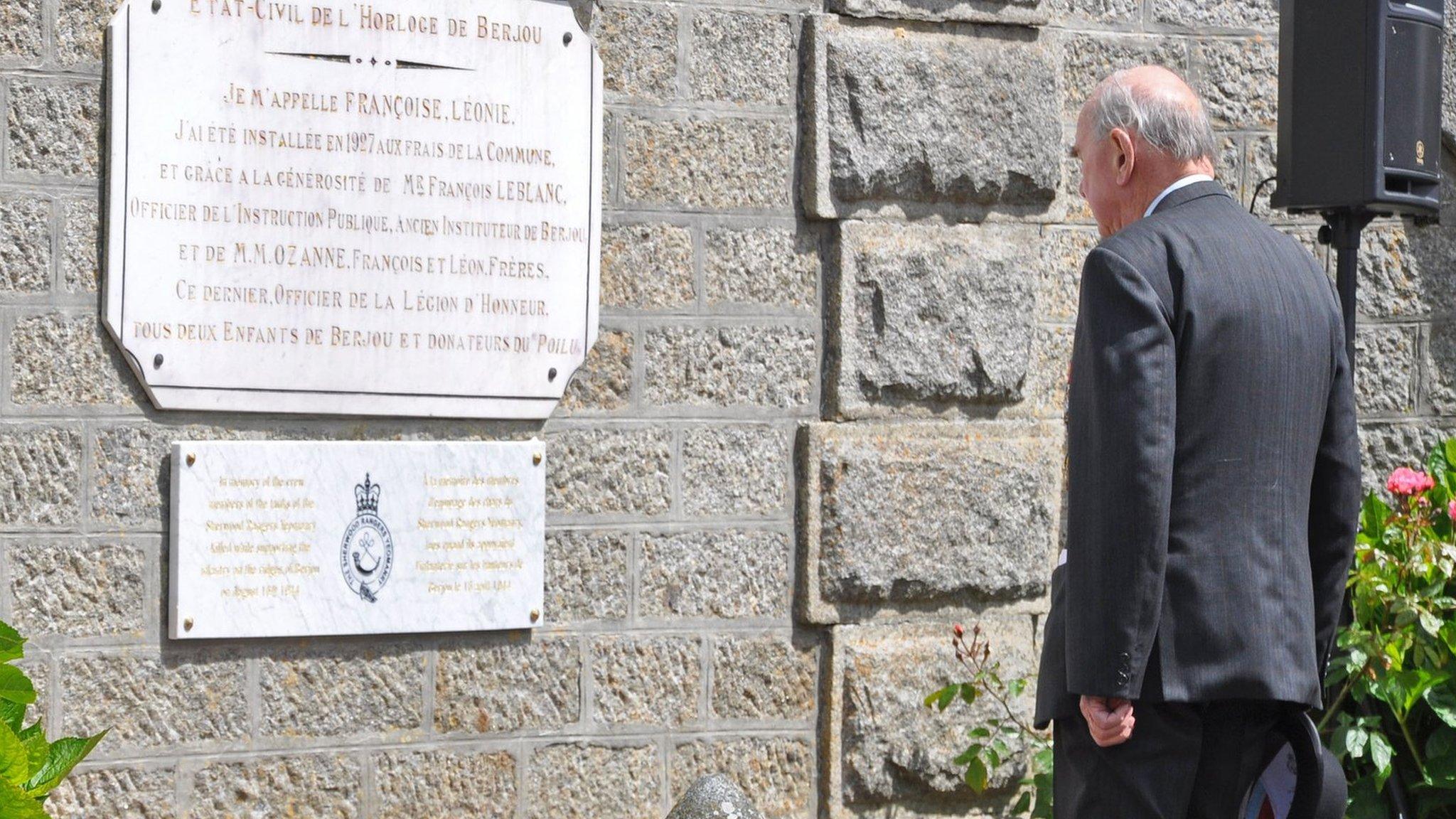
- Published8 January 2013

- Published13 January 2023